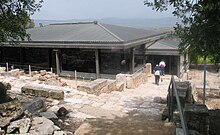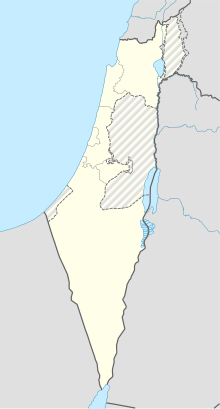
A synagogue, sometimes referred to as a shul or a temple, is a house of worship in Judaism. Synagogues have a place for prayer where Jews attend religious services or special ceremonies such as weddings, b'nai mitzvah, choir performances, and children's plays. They also have rooms for study, social halls, administrative and charitable offices, classrooms for religious and Hebrew studies, and many places to sit and congregate. They often display commemorative, historic, or modern artwork alongside items of Jewish historical significance or history about the synagogue itself.

A mosaic is a pattern or image made of small regular or irregular pieces of colored stone, glass or ceramic, held in place by plaster/mortar, and covering a surface. Mosaics are often used as floor and wall decoration, and were particularly popular in the Ancient Roman world.

Kafr ʿInān, is a former Palestinian village, depopulated in the 1948 Arab–Israeli war. It was located around 33 kilometres (21 mi) east of Acre.

Capernaum was a fishing village established during the time of the Hasmoneans, located on the northern shore of the Sea of Galilee. It had a population of about 1,500 in the 1st century AD. Archaeological excavations have revealed two ancient synagogues built one over the other. A house turned into a church by the Byzantines is believed to have been the home of Saint Peter.

The archaeology of Israel is the study of the archaeology of the present-day Israel, stretching from prehistory through three millennia of documented history. The ancient Land of Israel was a geographical bridge between the political and cultural centers of Mesopotamia and Egypt.

Gamla, alt. sp. Gamala was an ancient Jewish city on the Golan Heights. It is believed to have been founded as a Seleucid fort during the Syrian Wars which was turned into a city under Hasmonean rule in 81 BCE. During the Great Revolt, it became an important stronghold for rebels and because of this Gamla is a symbol for the modern state of Israel and an important historical and archaeological site. It lies within the current Gamla nature reserve and is a prominent tourist attraction.

Sepphoris, known in Hebrew as Tzipori and in Arabic as Saffuriya is an archaeological site located in the central Galilee region of Israel, 6 kilometres (3.7 mi) north-northwest of Nazareth. It lies 286 meters (938 ft) above sea level and overlooks the Beit Netofa Valley. The site holds a rich and diverse historical and architectural legacy that includes Hellenistic, ancient Jewish, Roman, Byzantine, early Islamic, Crusader, Mamluk and Ottoman remains. In the Roman period, it was also called Diocaesaraea. In Mandatory Palestine, Saffuriya was a Palestinian Arab town with a population of approximately 5000 people at the time of its depopulation in 1948.

Naaran is an ancient Jewish village dating to the 5th and 6th century CE, located in the modern-day West Bank. Remains of the village have been excavated north of Jericho, in Ephraim, between Bethel and Jericho. Naaran is archeologically notable for a mosaic floor of a synagogue, featuring a large zodiac design, which was discovered at the site.

Ehud Netzer was an Israeli architect, archaeologist and educator, known for his extensive excavations at Herodium, where in 2007 he found the tomb of Herod the Great; and the discovery of a structure defined by Netzer as a synagogue, which if true would be the oldest one ever found.
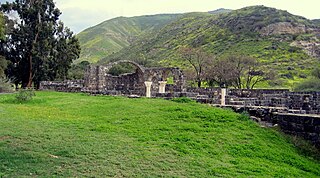
Kursi is an archaeological site in the Golan Heights containing the ruins of a Byzantine monastery and identified by tradition as the site of Jesus' "Miracle of the Swine". Part of the archaeological site is now an Israeli national park. Kursi takes its name from the Talmudic site. A marble slab with Aramaic text discovered in December 2015 seems to indicate that the settlement had, as of ca. 500 CE, a Jewish or Judeo-Christian population.
Beth Alpha is a sixth-century CE synagogue located at the foot of the northern slopes of the Gilboa mountains near Beit She'an, Israel. It is now part of Bet Alfa Synagogue National Park and managed by the Israel Nature and Parks Authority.

The ancient synagogue of Gaza was built in 508 CE during the Byzantine period and was discovered in 1965. It was located in the ancient port city of Gaza, then known as "Maiumas", currently the Rimal district of Gaza City.

The Maon Synagogue is a 6th-century synagogue and archaeological site located in the Negev Desert near Kibbutz Nirim and Kibbutz Nir Oz. It is noted for its "magnificent" mosaic floor.

Ancient synagogues in Israel refers to synagogues in the modern State of Israel, built by the Jewish and Samaritan communities from antiquity to the Early Islamic period.

Hammath Tiberias or Hammat Tiberias is an ancient archaeological site and an Israeli national park known as Hamat Tverya National Park, which is located on the adjacent to Tiberias on the road to Zemach that runs along the shore of the Sea of Galilee.
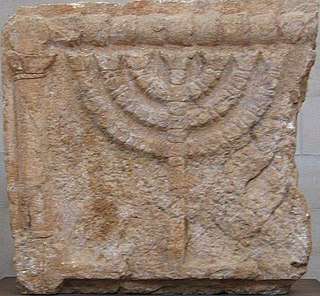
Ancient synagogues in Palestine refers to synagogues and their remains in the Palestine region, built by the Jewish and Samaritan communities from the time of the Hasmonean dynasty during the Late Hellenistic period, to the Late Byzantine period.

Huqoq or Hukkok was an ancient Jewish village, located 12.5 km north of Tiberias. The area had been settled since ancient times and is mentioned in the Book of Joshua. The Palestinian village Yaquq was built at Huqoq's location, and a kibbutz named Hukok was established near the site on 11 July 1945.

Shikhin, known in Greek as Asochis, was an ancient Jewish village in Galilee which was abandoned in the fourth century CE. It was situated right next to the regional capital, Sepphoris, and its ruins have been discovered about 8 kilometres (5.0 mi) northwest of Nazareth. As of May 2012, the site is under excavation. So far, evidence of extensive pottery work and a synagogue have been uncovered.
The Synagogue-Church at Gerasa in northwestern Jordan was originally an ancient Byzantine era synagogue that was later converted to a church. It is located within the Decapolis Gerasa and is situated on high ground that overlooks the Temple of Artemis at Gerasa. The synagogue is evidence of Jewish settlement in the Transjordan through late antiquity.
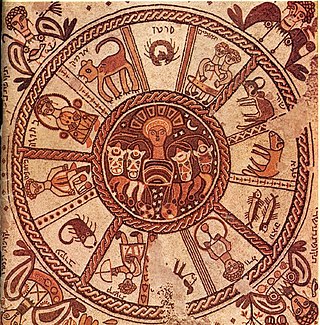
Synagogues from Israel of the 4th-6th centuries CE had three-panel mosaic floors, the center panel of which contained the Jewish zodiac.
